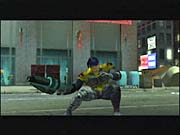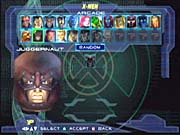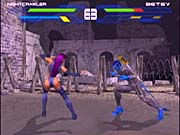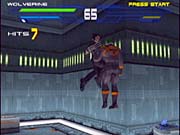Everyone's favorite band of mutants is back in X-Men: Next Dimension, a straightforward 3D fighting game initially released for the PlayStation 2 and GameCube and then released for the Xbox soon after. Created by Paradox Development, a company that's already done a couple of similar 3D fighting games (X-Men: Mutant Academy and its sequel) for the original PlayStation, X-Men: Next Dimension boasts a lineup of two-dozen popular Marvel Comics characters and the voice of Patrick Stewart. The game itself is decent, offering up a variety of different moves and letting players dish out long and damaging attack combinations--but it's not going to replace or even come close to your fighting game of choice, if you even have one these days. Then again, it's not like X-Men: Next Dimension is aimed at fighting game fans, since it's clearly geared toward fans of the X-Men comic book characters. These players will appreciate the wide selection of fighters in Next Dimension, as well as its story mode, though they'll wish the game did a better job of evoking these unique characters' personalities.

X-Men: Next Dimension features fully 3D renditions of all its characters, as well as interactive 3D backgrounds. However, the gameplay itself is clearly modeled after Capcom's Marvel Comics-based 2D fighting games such as X-Men: Children of the Atom and Marvel Super Heroes. Capcom's games are a lot older than X-Men: Next Dimension, but they did a lot of things better: Their controls were a lot more responsive, their gameplay was deeper, and they did a far superior job of bringing Marvel Comics' intriguing characters to life, thanks to some excellent hand-drawn 2D animation. X-Men: Next Dimension does sport 24 different characters, but they have just a single victory pose each, and many of their moves are awkwardly animated, making the fighters in the game seem far less interesting and entertaining than their comic book counterparts. Still, some fans will use their imaginations to fill in the blanks--you have to do that with comic books anyway--and will appreciate having so many of their favorite characters in a single game.

The game offers a number of different modes of play, including the usual suspects found in most any fighting game these days: There's an arcade mode in which you fight one computer-controlled opponent after the other in three-round matches, there's a practice mode for experimenting with moves and combos, there's a survival mode that challenges you to defeat as many opponents as possible without getting knocked out, there's a versus mode for two players, and there's the story mode that adds some much-appreciated context to the action. For some reason, only the GameCube version offers a time attack mode, in which you're trying to win matches as quickly as possible, and a team battle mode, in which you can select multiple fighters for a battle royal--the PS2 and Xbox versions lack these modes, but it's no huge loss.
The story mode is fairly unorthodox, insofar as it actually tells a story, unlike most fighting game story modes. The plot unfolds in numerous prerendered cinematic cutscenes interspersed between obligatory one-on-one matches, and it's about how the evil Bastion is attempting to do in mutantkind with his army of robotic sentinels and a dastardly plot to use the powers of one of the X-Men against them. The X-Men retaliate, but they also run into their nemesis Magneto, whom they'll have to join forces with if they hope to stop the greater threat. It's a good enough plot, and during the course of the story mode, you'll switch between having to control particular characters and getting to choose to play as one of several. You won't get to control all the game's characters in the story mode, but you'll also be glad that you don't get stuck with just one character for the duration of it.
The gameplay itself will be familiar to anyone who's played a fighting game lately. The face buttons on the controller are used to execute various punches and kicks that can be chained together in preset combinations. In addition to a variety of regular attacks, each character can also use a small number of special moves and four different super moves. As in the Street Fighter Alpha games (and many others), you charge up energy for your super moves by attacking repeatedly. Different sections of the super meter correspond to your different super moves, and X-Men: Next Dimension's twist is that you can transfer stored-up energy from one section of the super meter to another. Whether this is a necessary feature is debatable, however, as your super meter charges up quickly, allowing you to frequently use your most damaging moves. Besides that, the controller's shoulder buttons are also used to perform unblockable throws and reversals, which are useful for punishing overly defensive or overly aggressive opponents, respectively. Additionally, you can juggle opponents with successive hits in midair and pursue your attack against a foe who's been knocked down.

The concepts of the gameplay may be sound, but the success or failure of any fighting game hinges upon the execution. And, as mentioned, X-Men: Next Dimension isn't executed particularly well. The controls can be stiff and unresponsive, so even when you're controlling some of the game's speedier characters like Wolverine or Beast, you won't get the sense that you're in command of an extremely nimble fighter. Collision detection is a bigger problem, as sometimes your attacks will seem to harmlessly pass through the opponent, while other times attacks that seemed to miss will actually connect. Many characters jump too high and too far, so you'll often go sailing over the opponent's head by accident--you'll wish that characters could hop as well as leap. In general, the whole feel of the game--the way the characters interact with each other and their environment--just isn't quite right, almost as if all the characters were hollow. Though some of the fighters, such as the mighty Juggernaut and the robotic Sentinel-A, are large onscreen, even these seem a bit too floaty and lacking in mass. The game's balance is also pretty suspect, as some fighters have access to cheap moves that can be used repeatedly to good effect and without fear of repercussion. It's pointless to program each fighter with a variety of moves and combos when some of them can be abused.
X-Men: Next Dimension looks decent, with a consistently smooth frame rate and some rather large fighters. The fighters aren't particularly detailed, though, and the quality of their attack animations varies quite a bit, with some moves looking quite good and others failing to be convincing. The game's large 3D environments aren't just for show, as you can knock your foes into certain objects or send them flying off ledges onto lower levels, much like in the last few Dead or Alive games, only not as impressively executed. At any rate, the Xbox version of the game is the best looking of the three by a small margin, on account of its slightly richer colors and better picture clarity.

The disappointing audio in the game brings the whole experience down another notch. Though Patrick Stewart reprises his movie role as Professor X and provides the voice-over narration for the story mode, the audio during the actual fights is mediocre at best. There's a weak-sounding noise that's used for whenever someone gets hit, and the characters' grunts and groans are strangely quiet, while their occasional speech clips are greatly oversampled, echoing much louder than the rest of the sound effects. The game's musical score is way too melodramatic and heavy-handed for a straightforward fighting game like this.
A number of X-Men: Next Dimension's characters require unlocking, and various other extras--mostly alternate outfits for characters--can also be obtained from repeated play. Still, the problems with the fighting system will probably keep you from playing X-Men: Next Dimension extensively. It can be a fine game to play with casual gamer friends who are fans of the source material, but since a number of better fighting games starring the X-Men already exist, it's hard to get too excited about this one. In the end, even the most ardent X-Men fans should probably just rent Next Dimension rather than buy it.